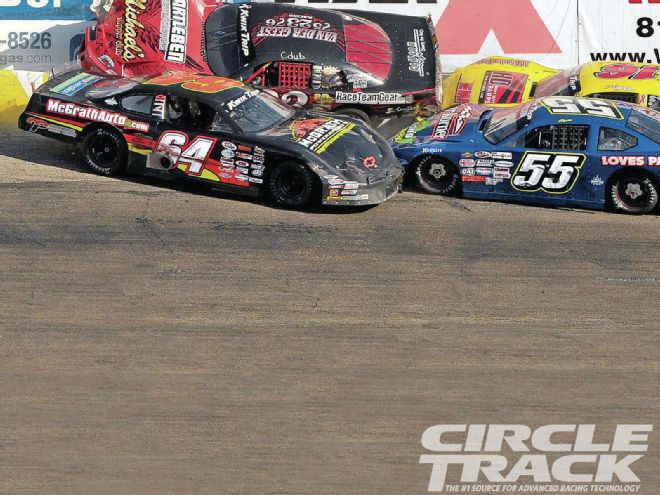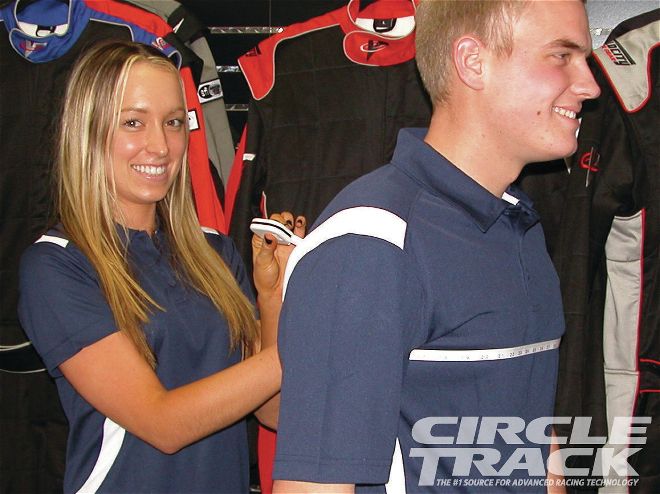
Did you know that you get roughly twice as much fire protection from an SFI-5 rated suit versus an SFI-1 rated suit?
Did you also know that there's about a $200 spread between a single-layer and double-layer suit?
Now let me ask you this: How many square inches of skin graft can you buy for $200?
Think about that for a minute. By spending a little extra money on a good quality suit you can save yourself a ton of money in medical bills if, God forbid, you experience a flash fire.
While nobody ever wants to talk about it, ours is a dangerous sport; fires can and do happen and a good firesuit is your first line of defense. There are essentially three types of suits; single-layer, double-layer, and triple-layer. In addition you have one-, two-, and even three-piece suits. Our opinion here at Circle Track is that drivers need to be wearing one-piece suits, crewmen can choose from any of the three multi-pieces depending upon their race day duty.
 <STRONG>1</STRONG> Chest: For the chest measurement, the chest circumference is measured under the arms at the widest point.
<STRONG>1</STRONG> Chest: For the chest measurement, the chest circumference is measured under the arms at the widest point.
TPP on the other hand refers to the garment's ability to provide thermal protection when exposed to both direct flame and radiant heat while taking into account the length of time before a person is subject to second-degree burns. While that's a mouthful, TPP is the second most important number you need to know when firesuit shopping. The TPP rating is derived from a mathematical calculation performed with the results of a sophisticated test procedure that utilizes two different heat sources, sensors, and the fabric to be tested. The TPP rating is divided in half to determine the number of seconds until the human tissue reaches a second degree burn. For example, if a particular fabric has a TPP rating of 35, it takes 17.5 seconds until a second-degree burn occurs in a flashover situation.
The only way to increase a TPP rating is through adding multiple layers. However, as you increase layers, suits get bulkier; and bulk doesn't equal comfort. Your goal in selecting a firesuit should be the balance of comfort with maximum protection.
Mom always told you to wear clean undies, now we know why. A great way to increase the TPP without jumping up to a three-layer drag racing suit is to wear fire-retardant underwear beneath your suit. If you're budget doesn't allow for FR underwear, even a cotton sweatshirt adds some protection.
Now, some suit manufacturers will promote the TPP rating of their suits alongside the SFI rating. Check out the chart on this page to determine which rating fits your particular needs.
OK, now here's a great question to ask yourself after looking at that chart. How fast can the safety crew at your local track get you out of a burning car? If they can do it in 3 seconds, go ahead and buy that $99 single-layer special and drop me a note telling me your home track because I want to race there.
Drivers come in all shapes and sizes so racing suit manufacturers offer a wide variety of standard sizes as well as custom "MTO" (made-to-order) racing suits. Most drivers can find a standard sized suit that will meet their performance and fit requirements, while other drivers are harder to fit and will require a custom suit.
Getting the proper measurement for standard racing suits require a few basic measurements of the driver. Standard racing suit measurements include the chest, waist, inseam, neck, height, and weight. Custom MTO race suits require additional measurements such as sleeve length, center back length, natural waist circumference, rise, thigh, hip, collar bone-to-crotch inseam (and bra size for female racers). Getting accurate measurements is critical to getting a racing suit that is comfortable and fits you properly.
There are a few important guidelines to follow to get an accurate measurement for your new racing suit. First and foremost, do not measure by yourself. Be sure to use a cloth measuring tape, commonly called a seamstress or tailor's tape measure. It is recommended that you take all measurements over well-fitting fireproof underwear or snug-fitting clothing. Do not take measurements over baggy or loose fitting clothing as you will not get accurate measurements. Be careful to not pull the tape too snug or too loose for the best accuracy. Finally, do not adjust measurements or make estimates or allowances in any way and be sure to take each measurement several times to ensure they are accurate.
It's important to note that some racing suit manufacturers use common sizing that we are familiar with in the United States (Small through XX-Large) while many others utilize Euro sizing (Euro 48 through 60) that are less familiar to most racers. Typically, the Euro sized racing suits are offered in an athletic cut that makes accurate measurement even more critical. There are also several more sizes available in Euro sizing range which provides the opportunity for a better fit. Unfortunately, many stocky drivers may find the athletic cut of Euro sized products to be too snug of a fit.
To demonstrate the correct method of measuring for a new racing suit, we asked Sprint Car drivers JoJo Helberg and Alissa Geving to help us with some photos to illustrate the measurement process. Photos 1-4 cover measurements for a standard suit while photos 5-12 are what you'll need to do for a custom-made suit.
In either case, you'll also need to provide your height which is easy to get an accurate measurement of. Without shoes on, stand against a wall, place a ruler on top of your head and make a mark with a pencil on the wall then measure the distance to the floor. Weight is important as well. Don't guess on this one, or put the weight you think you are going to be after that crash diet or the few weeks of brutal workouts you have been meaning to do at the gym. Get on an accurate scale and use your real weight.
Now that you have accurate measurements you can select the new racing suit of your choice that meets design and most importantly the safety requirements for your type of racing. We highly recommend a minimum of SFI 3.2A/5 Certification (SFI-5) when selecting a racing suit. We also highly recommend that you wear a fire-resistant base layer under your racing suit for added protection. This is especially important if you select a single-layer suit with an SFI 3.2A/1 certification (SFI-1) as these suits offer minimal protection. Many of today's choices of fire-resistant underwear feature fabrics that wick away moisture from the body and help to keep the driver cooler while providing enhanced protection from injury.
Tell them your ideal budget, the type of cars you race, your height, weight, and so on. They will be happy to talk with you and their technical people can suggest which suit best fits your application and price range. Do not forget to ask about TPP ratings. By simply asking you might find a little bonus. For example, in order to receive an SFI rating of 3.2A/5 you must achieve at least a TPP rating of 19. The key word there is "at least." It's not unheard of for a firesuit manufacturer to exceed the minimum rating and that's bonus fire protection.
Once you've determined that the stitching is three needle and high quality, try it on! While that sounds painfully obvious, I know guys who have bought suits without trying them on only to be disappointed in the fit when they get to the track. Squat down, move your arms and legs in a variety of positions. Who cares if you look stupid, remember that you're feeling for movement in a worst case scenario, getting out of a burning car fast!
Finally, remember the only way to increase the TPP rating is to add layers. You've got two choices here, thin layers of high-tech material add cost but deliver max comfort, thicker layers of lower-tech material add protection without more cost but increase bulk. That's why you need to try it on. What is comfortable on me may not feel good at all to you.
The difference between surviving a fire in your race car is your firesuit. choose the right one.